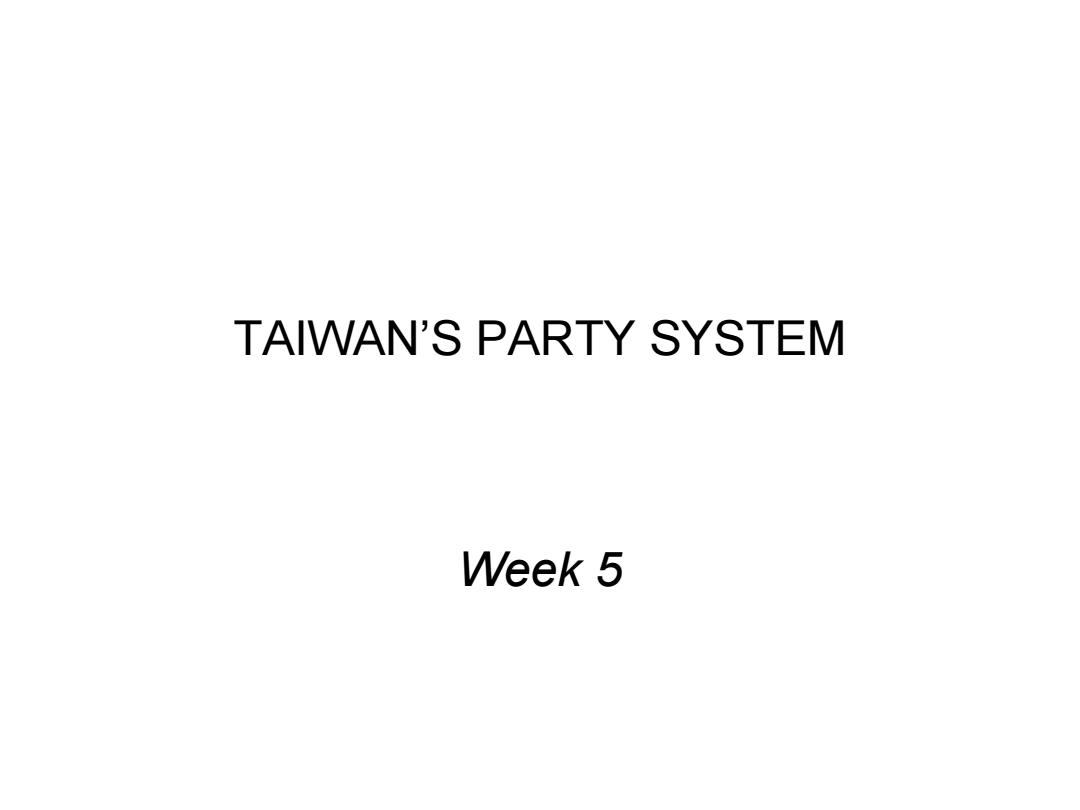
TAIWAN'S PARTY SYSTEM Week 5
TAIWAN’S PARTY SYSTEM Week 5
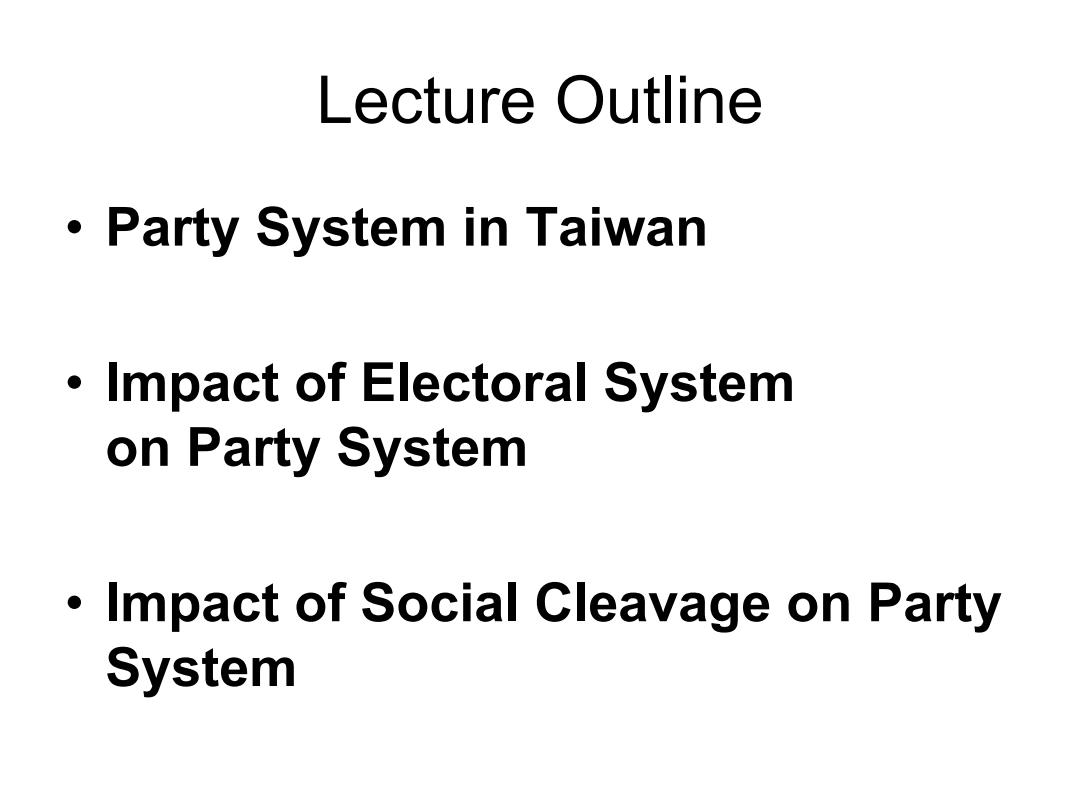
Lecture Outline Party System in Taiwan Impact of Electoral System on Party System Impact of Social Cleavage on Party System
Lecture Outline • Party System in Taiwan • Impact of Electoral System on Party System • Impact of Social Cleavage on Party System

1.Party System in Taiwan How many parties in Taiwan? -A.2:B.3:C.4:D.All are correct -How many relevant parties (Saotori)? ·De facto two parties?
1. Party System in Taiwan • How many parties in Taiwan? – A. 2; B. 3; C.4; D. All are correct – How many relevant parties (Saotori)? • De facto two parties?
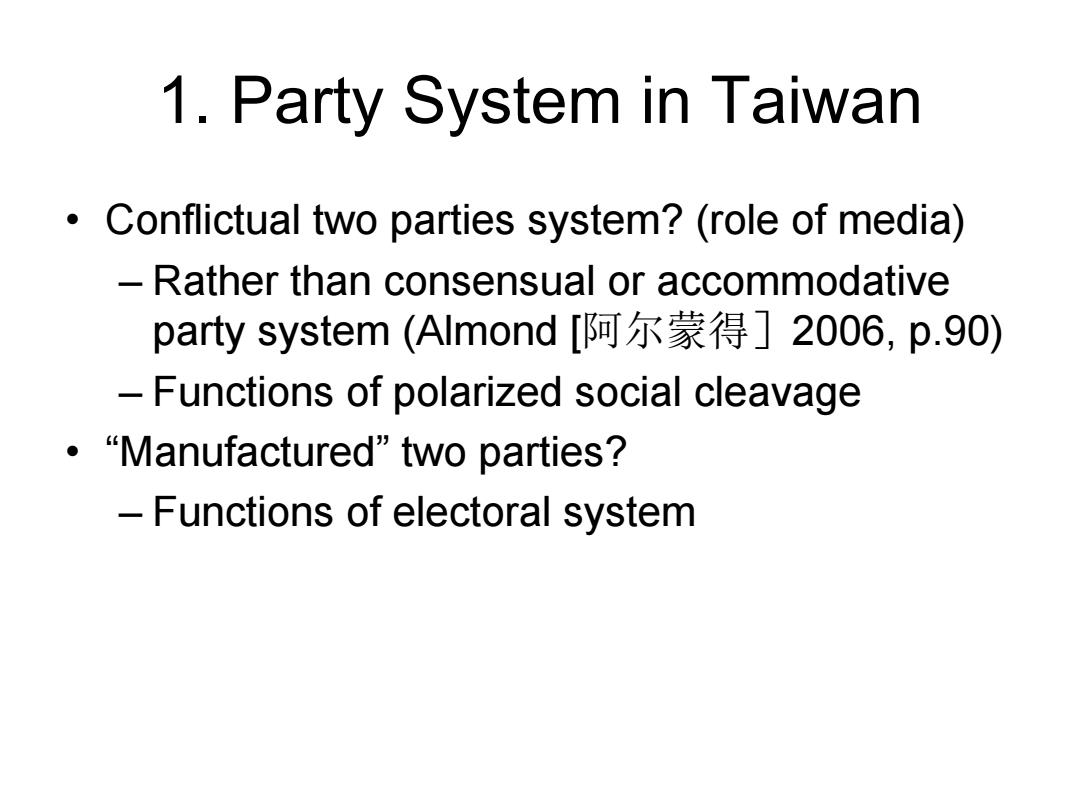
1.Party System in Taiwan Conflictual two parties system?(role of media) -Rather than consensual or accommodative party system(Almond[阿尔蒙得]2006,p.90) -Functions of polarized social cleavage ·“Manufactured”two parties? -Functions of electoral system
1. Party System in Taiwan • Conflictual two parties system? (role of media) – Rather than consensual or accommodative party system (Almond [阿尔蒙得]2006, p.90) – Functions of polarized social cleavage • “Manufactured” two parties? – Functions of electoral system
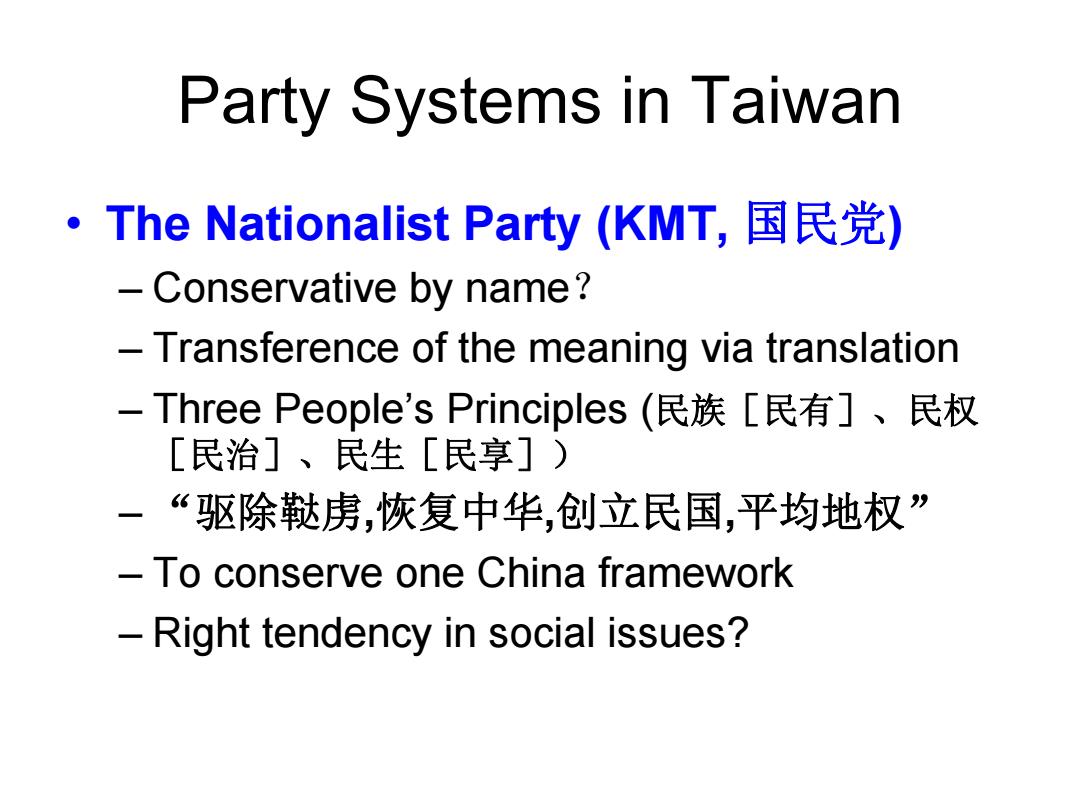
Party Systems in Taiwan ·The Nationalist Party(KMT,国民党) Conservative by name? Transference of the meaning via translation -Three People's Principles(民族[民有]、民权 [民治]、民生[民享]) 一“驱除鞑虏,恢复中华,创立民国,平均地权” To conserve one China framework Right tendency in social issues?
Party Systems in Taiwan • The Nationalist Party (KMT, 国民党) – Conservative by name? – Transference of the meaning via translation – Three People’s Principles (民族[民有]、民权 [民治]、民生[民享]) – “驱除鞑虏,恢复中华,创立民国,平均地权” – To conserve one China framework – Right tendency in social issues?

Party Systems in Taiwan
Party Systems in Taiwan
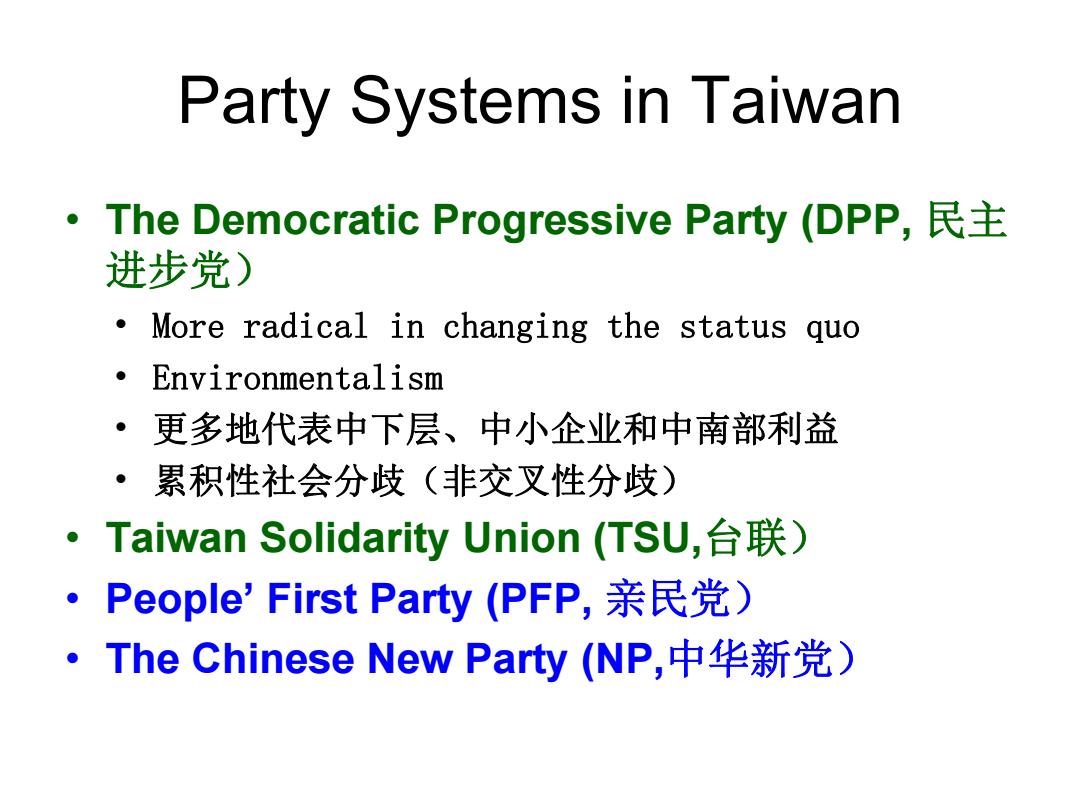
Party Systems in Taiwan 。The Democratic Progressive Party(DPP,民主 进步党) More radical in changing the status quo Environmentalism ·更多地代表中下层、中小企业和中南部利益 ·累积性社会分歧(非交叉性分歧) 。Taiwan Solidarity Union(TSU,台联) ·People'First Party(PFP,亲民党) ·The Chinese New Party(NP,中华新党)
Party Systems in Taiwan • The Democratic Progressive Party (DPP, 民主 进步党) • More radical in changing the status quo • Environmentalism • 更多地代表中下层、中小企业和中南部利益 • 累积性社会分歧(非交叉性分歧) • Taiwan Solidarity Union (TSU,台联) • People’ First Party (PFP, 亲民党) • The Chinese New Party (NP,中华新党)
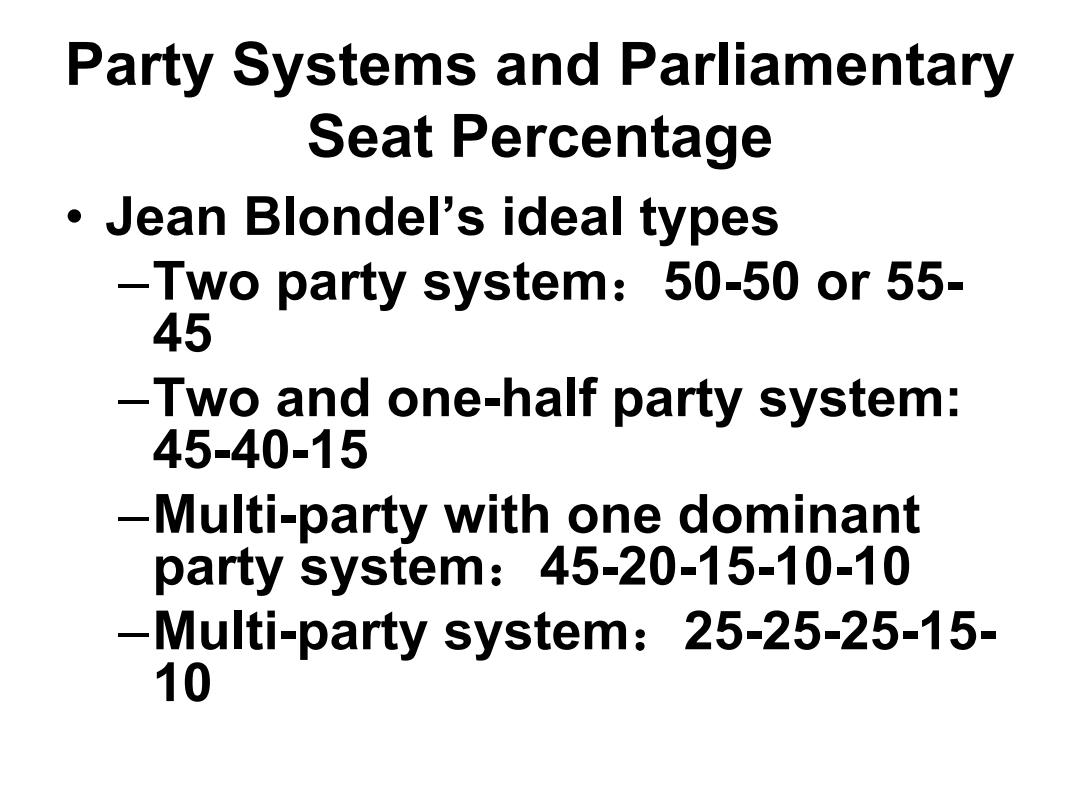
Party Systems and Parliamentary Seat Percentage Jean Blondel's ideal types -Two party system:50-50 or 55- 45 -Two and one-half party system: 45-40-15 -Multi-party with one dominant party system:45-20-15-10-10 -Multi-party system:25-25-25-15- 10
Party Systems and Parliamentary Seat Percentage • Jean Blondel’s ideal types –Two party system:50-50 or 55- 45 –Two and one-half party system: 45-40-15 –Multi-party with one dominant party system:45-20-15-10-10 –Multi-party system:25-25-25-15- 10

Vote and Seat Percentage in Legislative Yuan,2001-2012 2001:39%-30%-20%-6%-4%(Seat) ● 2004:40%-35%-15%-5%-4%(Seat) ·2008 (KMT vS.DPP): -Vote:53.5%VS.38.2%(“区域立委”得票率) -Seat:72%Vs.24%(总席位113席) 2012 (KMT vs.DPP): -Vote48.2%Vs.43.8%(44.6%Vs.34.6%) -Seat:56.6%(64)vs.35.4%(40)
Vote and Seat Percentage in Legislative Yuan, 2001-2012 • 2001: 39%-30%-20%-6%-4%(Seat) • 2004: 40%-35%-15%-5%-4%(Seat) • 2008 (KMT vs. DPP): – Vote:53.5% vs. 38.2% (“区域立委”得票率) – Seat:72% vs. 24% (总席位113席) • 2012(KMT vs. DPP): – Vote:48.2% vs. 43.8%(44.6% vs. 34.6%) – Seat:56.6% (64) vs. 35.4% (40)

2.Impact of Electoral System on Party System New electoral system for LV since 2008 -1 seat for 73 single-member districts .1998-2004:168 from multi-member districts -3 seats for each of the 2 multi-member districts ·1998-2004:4 for each -34 seats for proportional party representative system 1998-2004:49,including 8 for overseas) -73+6+34+113 ·1998-2004:225
2. Impact of Electoral System on Party System • New electoral system for LV since 2008 – 1 seat for 73 single-member districts • 1998-2004: 168 from multi-member districts – 3 seats for each of the 2 multi-member districts • 1998-2004: 4 for each – 34 seats for proportional party representative system • 1998-2004: 49, including 8 for overseas) – 73 + 6 + 34 + 113 • 1998-2004: 225